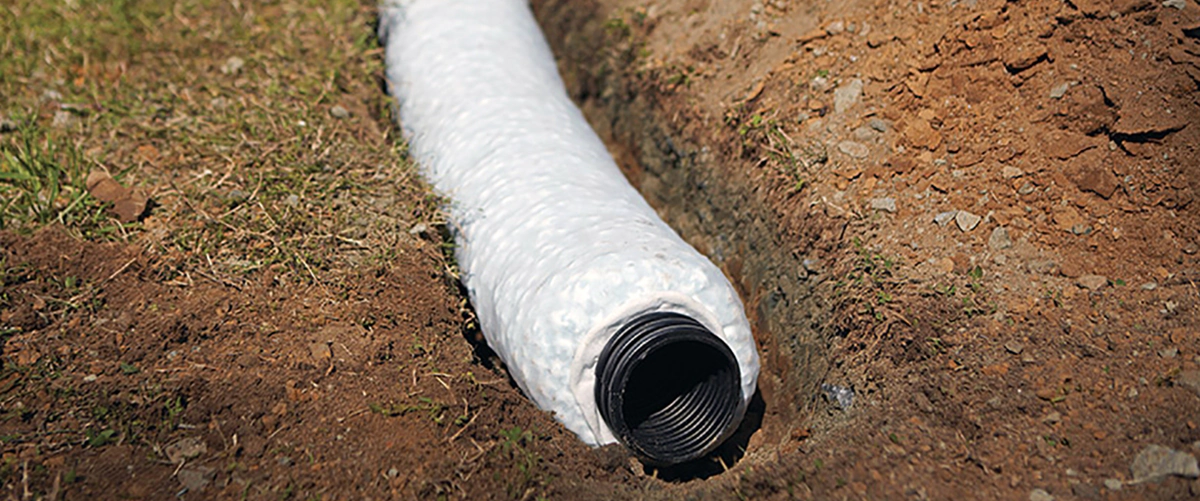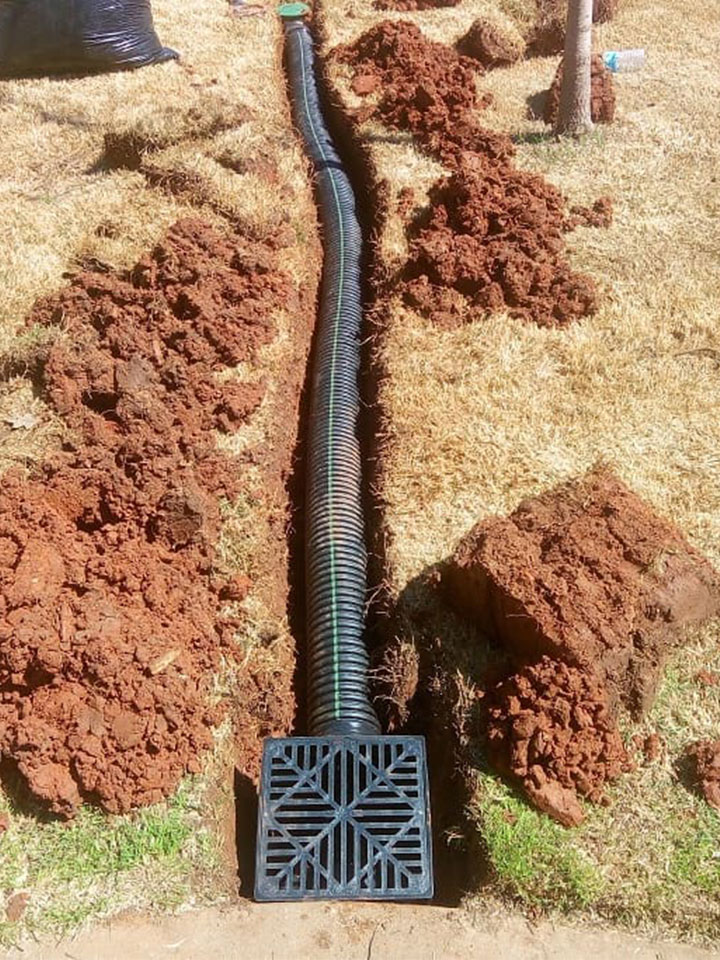The Crucial Overview to Preserving Your French Drain for Resilient Performance
Maintaining your French drainpipe is vital to its efficiency and your building's defense. Routine checks can save you from pricey fixings and water damages. You'll wish to know what indicators to seek and just how commonly to inspect your system. Plus, recognizing the cleansing process can make a significant difference. Allow's explore the important actions for guaranteeing your drainpipe works well for several years to come.
Comprehending the Feature of a French Drain
A French drain is a critical part in taking care of water around your home. It guides excess water away from your foundation, stopping flooding and damage. When hefty rainfall drops, the drain collects water via a perforated pipe buried in gravel. This system permits water to flow openly, reducing pressure on your basement wall surfaces and reducing the threat of leaks.You could ask yourself exactly how it functions in practice. As water saturates the soil, gravity pulls it towards the drainpipe. The perforated pipe catches this water, carrying it to a marked water drainage area or storm drain. This process keeps your yard dry and secures your home's structural integrity.Understanding just how a French drain features is vital to appreciating its importance. By properly funneling water away, it aids preserve a dry and secure living setting. Keeping your French drainpipe in top condition assurances you avoid expensive fixings down the line.
Routine Evaluations: What to Look For
When you're checking your French drain, begin by looking for any clogs that could be blocking water circulation. Take notice of signs of surface area erosion around the drain, as this can suggest prospective issues. Routine evaluations will certainly assist maintain your drainage system functioning effectively.
Obstructed Drain Assessment
Just how can you inform if your French drainpipe is clogged? Watch for water pooling in your lawn, particularly after heavy rainfall. If you discover locations where water gathers rather than draining, that's a warning. You ought to also inspect the drain electrical outlet; if water isn't streaming out as it should, there's likely a clog. Listen for uncommon gurgling audios, which can show trapped air. In addition, inspect the drain's surface area for any kind of plants growth, as origins can infiltrate and block the system. If you smell mildewy smells, it can direct to stagnant water created by a blockage. Routinely reviewing these signs can assist you keep your French drain successfully and protect against costly repair services.
Surface Disintegration Examine

Cleansing Your French Drain: Step-by-Step Guide
Cleaning your French drain is essential for maintaining it operating effectively. You'll require some particular devices and a clear procedure to assure whatever runs smoothly. Allow's stroll through the steps and suggestions for keeping your drainpipe successfully.
Tools You'll Need
To tackle the task of cleansing your French drain successfully, you'll wish to gather a few crucial devices. Initially, get a sturdy set of handwear covers to secure your hands from debris and sharp things. A tiny shovel or trowel will certainly help you get rid of dust or blockages around the drainpipe. For removing the inside, a plumbing professional's snake or a high-pressure water nozzle can be unbelievably valuable. You'll likewise require a container for gathering any particles you draw out. Ultimately, having a garden tube on hand will make it simpler to wash out the drain and guarantee it's moving smoothly. With these tools prepared, you'll be set for a complete cleansing session!
Cleansing Process Actions
Beginning by evaluating the area around your French drain for any kind of noticeable particles or clogs. Remove fallen leaves, branches, or dirt that might block water circulation. Next off, examine the inlet and outlet locations; clear any obstructions to ensure proper water drainage. Make use of a garden hose pipe to flush the drainpipe, directing water into the inlet. This assists remove any type of collected sludge or debris. Take into consideration making use of a plumber's snake to break them up if you notice persistent clogs. After cleaning, examine the crushed rock around the drainpipe; renew it if it's removed. Validate the drain covers are intact and firmly in area to prevent debris from entering. Regular cleaning maintains your French drainpipe functioning effectively.
Upkeep Regularity Tips
While normal upkeep is important for your French drain's longevity, recognizing just how frequently to preserve it can make all the distinction. Ideally, you ought to examine your French drain at the very least two times a year, preferably in spring and autumn. After heavy rainfall or snowmelt, check for blockages or debris. If you observe any kind of standing water, it's time to cleanse your drain.In areas with heavy foliage, more regular upkeep-- regarding every three months-- might be necessary. In addition, think about cleaning your French drainpipe after major storms or if you observe water pooling in your backyard. By staying proactive, you'll guarantee your French drain functions effectively and secures your property from water damage. Regular checks will certainly save you money and time in the future.
Identifying Typical Issues and Their Solutions
It's vital to recognize typical concerns with your French drainpipe and implement effective options when you see water pooling in your backyard or damp areas in your basement. One regular problem is obstructing, commonly created by particles like leaves or sediment. To repair this, you can use a plumbing snake or a high-pressure water jet to clear blockages.Another concern could be inappropriate incline. Water won't stream away from your home if your drain isn't sloped properly. You can readjust the slope by digging and repositioning the drain pipe.Lastly, check for damages or splits in the drainpipe itself. If you locate any kind of, replacing the damaged areas is crucial for peak performance. By attending to these issues promptly, you'll assist ensure that your French drain remains to operate properly, securing your residential or commercial property from water damages and keeping a dry, safe environment.
Seasonal Maintenance Tips for Your French Drainpipe
Resolving common issues with your French drainpipe is just the very first step in ensuring its lasting performance. Seasonal maintenance is important for peak performance. In the springtime, pop over to these guys clear away leaves and particles that may have collected during winter months. Check for any clogs in the outlet or catch basin, as water needs a clear path to move freely.During summertime, examine your drain for any kind of indicators of settling or moving dirt. Make sure it's still level and working correctly. As fall approaches, clear out any fallen entrusts to prevent obstructions prior to wintertime arrives.In winter season, expect freezing temperatures. Make certain your drain isn't at threat of cold if you live in a chilly climate. Shielding subjected pipelines can aid. Regular checks and prompt maintenance can protect against pricey fixings and keep your French drainpipe functioning properly year-round. Keep positive and take pleasure in satisfaction knowing your drain system is in excellent shape!
When to Hire a Specialist
When to call in an expert can save you time and avoid further damage to your French drainpipe, knowing. It's a clear indicator that your drain might be obstructed or damaged if you observe persistent standing water in your lawn. Don't disregard odd smells, as they can indicate sewer backup or degeneration, which requires prompt attention.If you discover that your drain isn't functioning appropriately after efforts to tidy or maintain it, it's time to reach out for specialist aid. In addition, if you're unclear about the underlying issues or do not have the needed tools, working with a professional can provide peace of mind.Finally, if your French drainpipe is old or has actually experienced substantial deterioration, professional evaluation can figure out whether repairs or total replacement is needed. Trust the specialists to ensure your water drainage system functions effectively for many years to find.
Tips for Preventing Future Drain Troubles
To keep your French drain functioning effectively, on a regular basis evaluating and keeping it can make all the difference. Beginning by clearing debris, leaves, and dirt from the surface area and drainpipe openings. This stops blockages that can bring about water back-up. Check the crushed rock around the drainpipe; if it's compacted or worn down, consider adding fresh gravel to keep ideal flow.Next, divert water far from your drain by making sure seamless gutters and downspouts are clear and directing water a minimum of three feet away from your foundation. On a regular basis inspect for any kind of indications of damage or sagging. If you observe issues, resolve them immediately.Finally, take into consideration mounting a catch or a filter container to trap bigger particles before it goes into the drain. By remaining positive with these suggestions, you'll lessen the risk of future drain problems and keep your French drainpipe in top form.
Frequently Asked Inquiries
For how long Does a French Drain Normally Last?
A French drainpipe commonly lasts around 30 to 40 years, depending on the products used and maintenance (Portland French Drain). If you stay on par with routine checks, you can extend its life-span also further
Can I Install a French Drainpipe Myself?
Yes, you can mount a French drain yourself if you've obtained dig this the right devices and expertise. Simply ensure to prepare thoroughly, follow neighborhood policies, and guarantee proper water drainage to avoid future issues.
What Products Are Utilized in a French Drain?
You'll require perforated pipe, crushed rock, landscape textile, and a strong drainage pipe for your French drainpipe. These products assist reroute water effectively, preventing flooding and maintaining your residential property secure and dry from water damage.

Is a Permit Required to Install a French Drainpipe?
You'll likely need a permit to install a French drain, depending on regional laws. Contact your district to ensure you follow any required standards and avoid possible issues during installation.
What Are the Prices Connected With French Drain Maintenance?
Preserving a French drainpipe generally costs between $100 and $500 every year. You'll require to think about expenses for cleaning, repair services, and inspections. Normal upkeep helps protect against bigger expenses and guarantees your system functions appropriately for several years - Portland French Drain. When you're checking your French drainpipe, begin by inspecting for any type of clogs that may be obstructing article source water flow. By remaining aggressive, you'll assure your French drainpipe features successfully and protects your residential or commercial property from water damage. When you notice water merging in your yard or damp spots in your cellar, it's vital to determine usual issues with your French drain and implement efficient options. You can readjust the slope by digging and repositioning the drain pipe.Lastly, check for damages or cracks in the drain itself. Check the crushed rock around the drain; if it's compressed or worn down, consider including fresh gravel to maintain suitable flow.Next, draw away water away from your drainpipe by ensuring downspouts and seamless gutters are clear and directing water at the very least 3 feet away from your structure